Make cities and human settlements inclusive, safe, resilient and sustainable
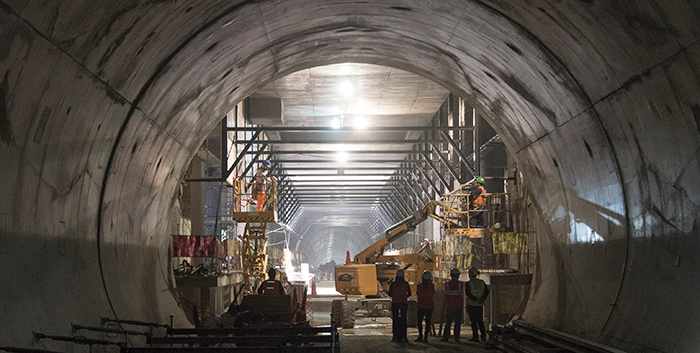
A metro line tunnel and station providing a safer and more sustainable transport system is under construction in Lima, Peru.
© World Bank/Yayo Lópezresilient and sustainable urban development policies and practices that prioritize access to basic services, affordable housing, efficient transportation and green spaces for all.
Smaller cities and towns in many regions are recording faster growth in slum populations than major cities
The world’s population reached 8 billion in November 2022, with over half (55 per cent) living in urban areas, a figure projected to rise to 70 per cent by 2050. Most of the urban growth is taking place in small cities and intermediate towns, exacerbating inequalities and urban poverty. While the proportion of the urban population living in slums declined slightly, from 25.4 to 24.2 per cent between 2014 and 2020, the total number of slum dwellers continues to rise with increasing urbanization. In 2020, an estimated 1.1 billion urban residents lived in slums or slum-like conditions. Over the next 30 years, an additional 2 billion people are expected to live in such settlements – some 183,000 people daily – mostly in developing countries. Today, 85 per cent of slum dwellers are concentrated in three regions: Central and Southern Asia (359 million), Eastern and South-Eastern Asia (306 million) and sub-Saharan Africa (230 million). The escalating slum population is a manifestation of the housing crisis, highlighting the need for diverse housing options, equitable public transportation and basic services to meet the varied needs of urban residents.
Proportion of global urban population living in slums (percentage) and total slum population (millions), 2000–2020
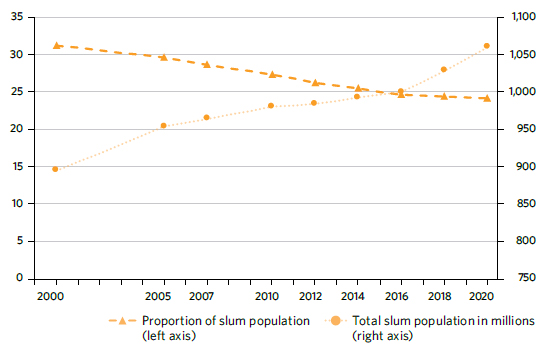
The demand for urban transportation continues to grow exponentially, particularly in developing countries
The quality and availability of transportation infrastructure varies greatly across countries and regions and even within cities. In developed countries, people tend to have more than one transportation option, although these are not always available in an equitable or environmentally sensitive manner. But in the developing world, where an estimated 1 billion people still lack access to all-weather roads, the demand for mobility for people and goods has been expanding exponentially every year. Data from 2022 reveal that only 51.6 per cent of the global urban population has convenient access to public transport, with considerable regional differences. Countries and cities, particularly in the developing world, still have a long way to go in terms of developing safe, affordable, accessible and sustainable transport systems. There is a pressing need for cities worldwide to integrate motorized transportation systems with walking and cycling through long-term sustainable urban mobility plans, targeted infrastructure investments and policy implementation.
Coverage of public transport and share of population with convenient access in urban areas, 2022 (percentage)
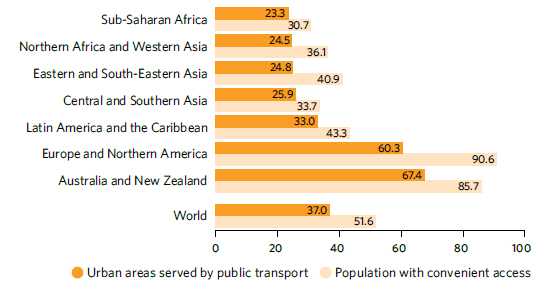
Note: Based on data from 1,507 cities in 126 countries.
Air pollution is not only an urban problem, but is also affecting towns and rural areas
Globally, air quality is improving, largely due to advancements in high-income countries. However, small island developing States (SIDS) are experiencing either stagnant or worsening air quality levels, albeit lower than the global average. To compound matters, air pollution monitoring in these countries is limited or non-existent. Low- and middle-income countries account for only 42 per cent of the 117 countries reporting air pollution data from cities, and SIDS represent a mere 3 per cent of these countries. Although cities have traditionally been the focus of air pollution reduction policies, air quality in towns and rural areas should also be considered. In 2019, towns in Eastern and South-Eastern Asia, a region with a significant proportion of the world’s population, experienced poorer air quality than cities. Tackling air pollution requires a shift in perspective, acknowledging that it is not solely an urban issue. While urban areas continue to be important, a comprehensive approach that also considers towns and rural areas is crucial to combat air pollution effectively.
Population-weighted particulate matter (PM2.5) concentrations in cities, towns and rural areas, 2019 (micrograms per cubic metre)
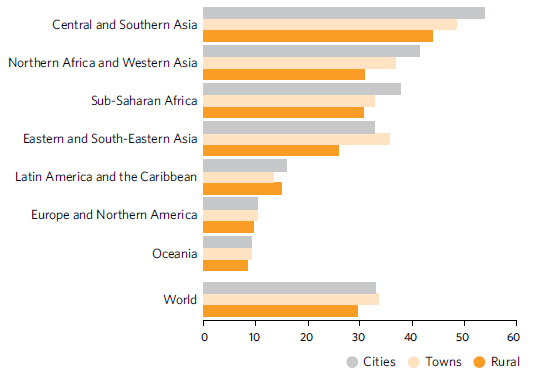
Provision and access to open public spaces remains low across regions, impacting negatively on the quality of urban life
Public spaces enhance inclusion, social cohesion and the productivity of cities. However, 2020 data from 1,072 cities reveal that more than three-quarters have less than 20 per cent of their area dedicated to open public spaces and streets. This figure falls short of the target of 45–50 per cent, of which 15–25 per cent should be open public spaces and 30–35 per cent streets and sidewalks. On average, open public spaces accounted for a mere 3.2 per cent of urban land in 2020, about four times less than the share occupied by streets. However, these figures vary widely across regions, and cities in more developed regions have higher proportions of land dedicated to streets and open spaces than those in developing regions. Furthermore, countries in developed regions also have higher shares of the population with convenient access to open public spaces.
Proportion of cities in each region where the population has access to open public spaces, within a 400-metre walking distance, 2020 (percentage)
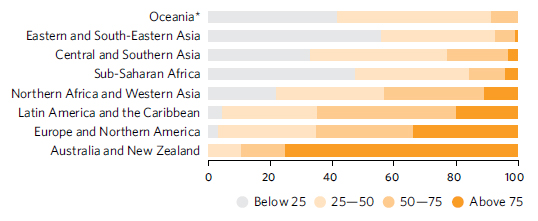
*Excluding Australia and New Zealand.
Urban sprawl is outpacing population growth in most cities, with detrimental effects on sustainability
Data from 681 cities spanning 30 years reveal that the global physical expansion of cities has outpaced population growth. For the period 1990–2000, the global land consumption rate averaged 2.9 per cent, while the population growth rate averaged 2.3 per cent. These rates declined to 2.0 per cent and 1.6 per cent respectively for the period 2000–2010, and further declined to 1.5 per cent and 1.2 per cent respectively in 2010–2020. The overall steady decline in both the population growth rate and land consumption rate was observed in all regions, except Northern Africa and Western Asia, where a higher population growth rate was recorded during the 2000–2010 period than in 1990–2000. The resulting urban sprawl results in cities becoming less dense as they expand, but its unplanned nature has detrimental effects on the sustainability of urban development.
Since 2015, many more national and local governments have reported having disaster risk reduction strategies
The number of countries with national disaster risk reduction strategies has increased from 55 in 2015 to 126 by the end of 2022. One crucial aspect of these strategies is to promote policy coherence and compliance, notably with the SDGs and the Paris Agreement – with 118 countries reporting having some degree of policy coherence. In addition to national efforts, local governments worldwide have also made progress on developing and implementing local disaster risk reduction strategies in line with national strategies. By the end of 2022, a total of 102 countries reported having local governments with disaster risk reduction strategies, a substantial increase from 51 in 2015. Among these countries, the average proportion of local governments that have local disaster risk reduction strategies is 72 per cent.

